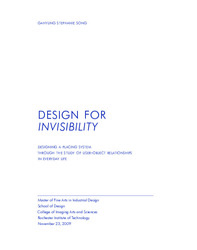Design for invisibility: designing a placing system through the study of user-object relationships in everyday life
Abstract
The world we live in is a place where people are influenced by designed
objects, often without noticing their presence or the fact that they have
been designed at all. Although these objects are taken for granted their
impact on our everyday life is immeasurable. By examining designed
objects with regard to their relationship to users, this thesis attempts
to rediscover the meaning of design in everyday life by encouraging a
fluid user-object relationship, rather than a passive consumer-product
relationship.
It is important to understand the everyday phenomena by which designed
objects become invisible when they fit one's environment well. So many
products that would claim to help us organize our stuff are actually
incompatible with our behaviors. This thesis project seeks to introduce a
new placing system that better responds to people's actual placing habits.
In order to design this highly user-adaptable system, I will (a) exploit the
space around and between objects, (b) rediscover and transform existing
planes of the space, and (c) apply a minimalist philosophy to show the
essence of an object and avoid secondary or ornamental elements.
This placing system resembles that of tinker toys in its modular frame
assembly. This modularity encourages active user participation beyond
what is required in existing products. The other important attribute it
introduces is the affordance of placing as an organizing strategy. In the
end, what will become more visible are the users' habits and personal
surroundings, rather than the presence of a designed product. Such is the
goal of objects designed for invisibility.
Collections
The following license files are associated with this item:

